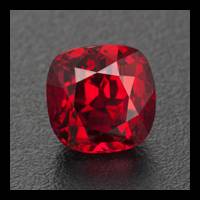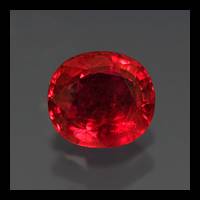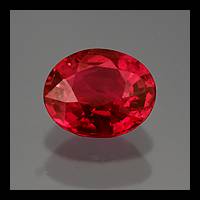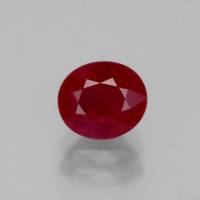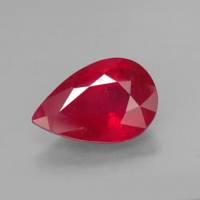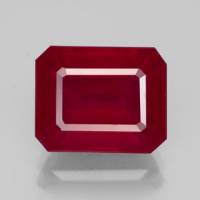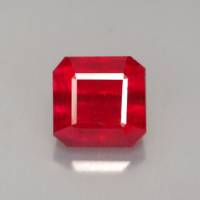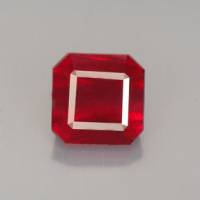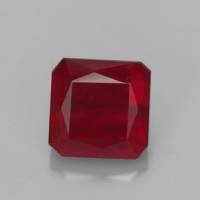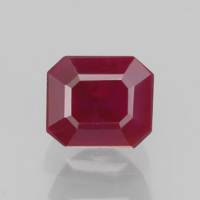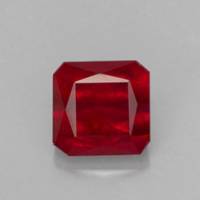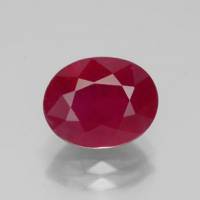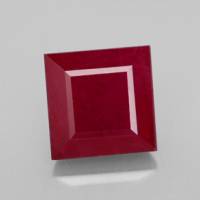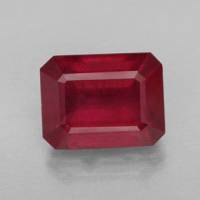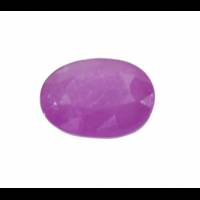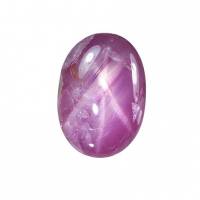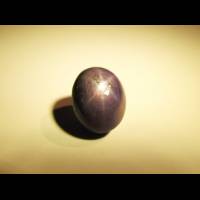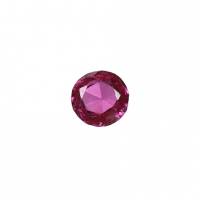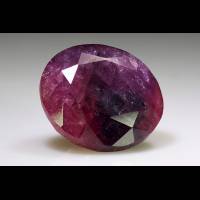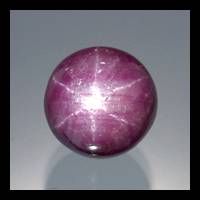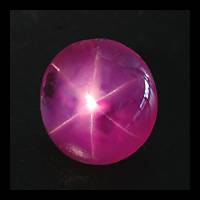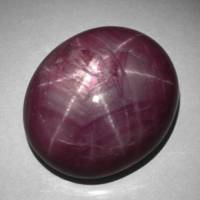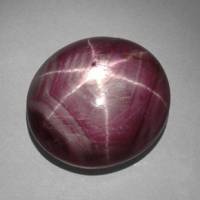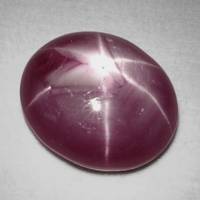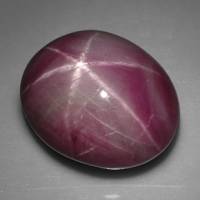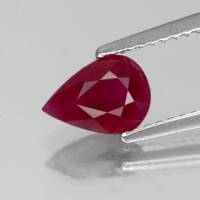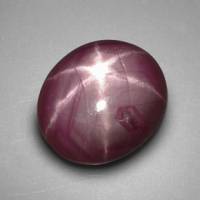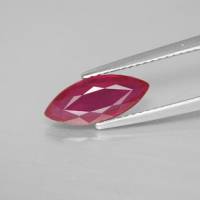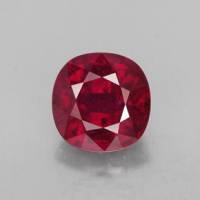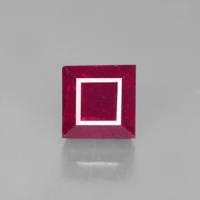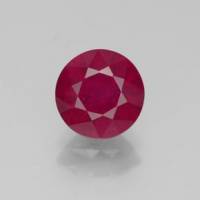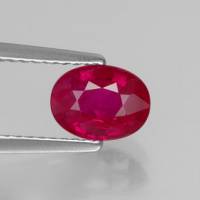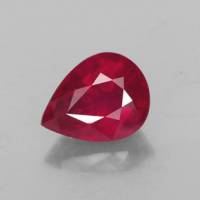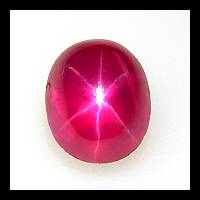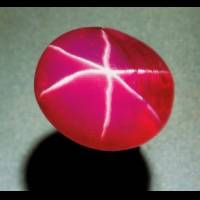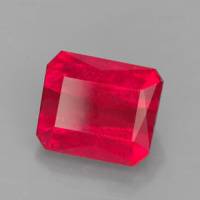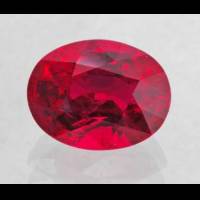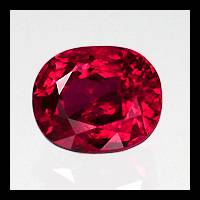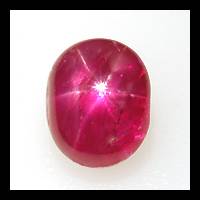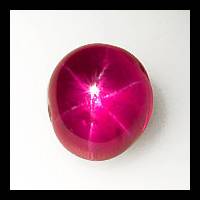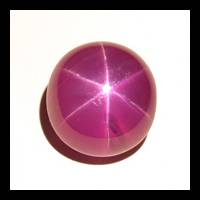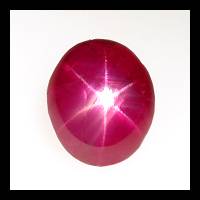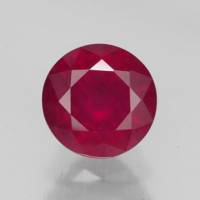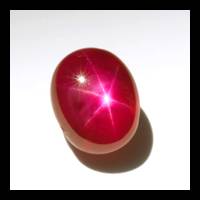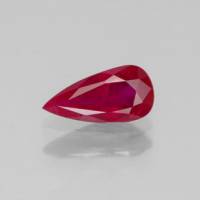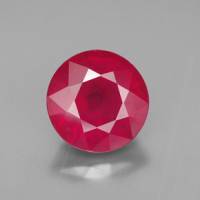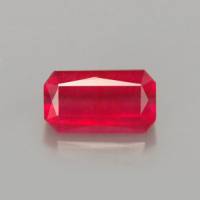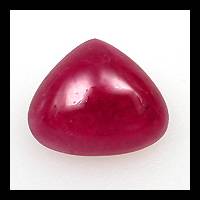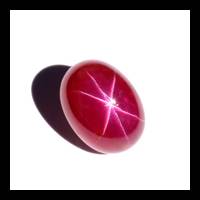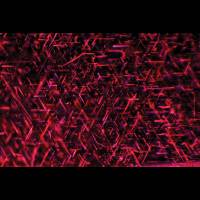Ruby
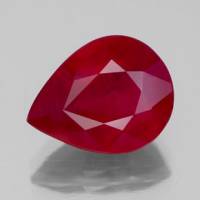
Madagascar
6.29 carats
© gemselect.com
The red colour can vary within each individual deposit, therefore the determination of the source from the colour is not possible. The red colour is caused by chromium, and in case of brownish tones due to presence of iron.
The rough stone has dull and greasy lustre.
Inclusions are common and often indicate that the stone is natural.
Ruby Gemstones by Colour
This table shows the variety of hues this gemstone can be found in. Click on a photo for more information.
Ruby Gemstones by Size
This table shows distribution of Ruby gemstone sizes that are listed on this site. This can give a good indication as to the general availability of this gemstone in different sizes.
Contributed photos
Lightest:0.12 cts
Heaviest:100.32 cts
Average:4.89 cts
Total photos:120
Do you have a larger Ruby? Why not upload a photo?
Significant stones
Eminent Star6,465 cts
Ecce Homo Star Ruby2,890 cts
Edwardes Ruby167 cts
Rosser Reeves Star Ruby139 cts
Anne of Brittany's105 cts
| General Information | ||||||||||||||||||||||||||||||||||||||||||||||
|---|---|---|---|---|---|---|---|---|---|---|---|---|---|---|---|---|---|---|---|---|---|---|---|---|---|---|---|---|---|---|---|---|---|---|---|---|---|---|---|---|---|---|---|---|---|---|
| A variety or type of: | Corundum | |||||||||||||||||||||||||||||||||||||||||||||
| Varieties/Types: | Flux-Grown Ruby - A synthetic ruby grown from alumina dissolved in a molten flux. Geneva Ruby - Earliest synthetic rubies (circa 1885) created in Geneva. Star Ruby - A chatoyant ruby showing asterism. Verneuil Ruby - A synthetic ruby created using the flame fusion process. | |||||||||||||||||||||||||||||||||||||||||||||
| Chemical Formula |
| |||||||||||||||||||||||||||||||||||||||||||||
| Significant stones | ||||||||||||||||||||||||||||||||||||||||||||||
| ||||||||||||||||||||||||||||||||||||||||||||||
| Ruby Treatments | ||||||||||||||||||||||||||||||||||||||||||||||
| Heat-treatment may create a superficial chalky-blue reaction. May be dyed (especially cabochons): color concentration in cracks. Acetone test. Diffusion: may show orangy color concentration/rim under surface. May show blue haloes/spots (internal diffusion). May be surface diffused (chromium): rare. Glass filling: rounded and flattened gas bubbles, glassy residues. Reflecting light: filled cracks may show a distinct surface lustre. Lead-glass (and some other high refractive glasses) may be revealed by bluish to orangy flashes seen when looking parallel to filled cracks, using dark-field or fiber-optic light. Some glass-filled rubies may not show colored flashes nor show obvious gas bubbles. Sensitive to solvents - Blue Chart Gem Identification, Herve Nicolas Lazzarelli, 2010, p. 2 Lattice diffusion with beryllium enhances the colour giving orangy-red or red face-up colour. Fracture-filling with high-lead-content glass.Exposure to chemicals (even some household cleaners) can damage the filler material and make fracture more visible. - GIA, 2018 | ||||||||||||||||||||||||||||||||||||||||||||||
| Ruby Simulants | ||||||||||||||||||||||||||||||||||||||||||||||
| Imitation rubies are also marketed. Red spinels, red garnets, and colored glass have been falsely claimed to be rubies. Imitations go back to Roman times and already in the 17th century techniques were developed to color foil red—by burning scarlet wool in the bottom part of the furnace—which was then placed under the imitation stone. | ||||||||||||||||||||||||||||||||||||||||||||||
| Synthetic Ruby | ||||||||||||||||||||||||||||||||||||||||||||||
| In 1837 Gaudin made the first synthetic rubies by fusing potash alum at a high temperature with a little chromium as a pigment. In 1847 Ebelmen made white sapphire by fusing alumina in boric acid. In 1877 Frenic and Freil made crystal corundum from which small stones could be cut. Frimy and Auguste Verneuil manufactured artificial ruby by fusing BaF2 and Al2O3 with a little Chromium at red heat. In 1903 Verneuil announced he could produce synthetic rubies on a commercial scale using this flame fusion process. By 1910, Verneuil's laboratory had expanded into a 30 furnace production facility, with annual gemstone production having reached 1,000 kg (2,205 lb) in 1907. Other processes in which synthetic rubies can be produced are through the Czochralski's Pulling process, flux process, and the hydrothermal process. Most synthetic rubies originate from flame fusion, due to the low costs involved. Synthetic rubies may have no imperfections visible to the naked eye but magnification may reveal curves, striae and gas bubbles. The fewer the number and the less obvious the imperfections, the more valuable the ruby is; unless there are no imperfections (i.e., a "perfect" ruby), in which case it will be suspected of being artificial. Dopants are added to some manufactured rubies so they can be identified as synthetic, but most need gemological testing to determine their origin. Synthetic rubies are used for watches and bearings, formerly the most important technical application for natural stones. - Gemstones of the world, Walter Schumann, 2001, p 82 | ||||||||||||||||||||||||||||||||||||||||||||||
| Physical Properties of Ruby | ||||||||||||||||||||||||||||||||||||||||||||||
| Mohs Hardness | 9, Blue Chart Gem Identification (2010) More from other references | |||||||||||||||||||||||||||||||||||||||||||||
| Specific Gravity | 3.97 to 4.05, Gemstones of the world (2001) More from other references | |||||||||||||||||||||||||||||||||||||||||||||
| Tenacity | Brittle, Gems, Sixth Edition (2006) | |||||||||||||||||||||||||||||||||||||||||||||
| Cleavage Quality | None, Gems, Sixth Edition (2006) | |||||||||||||||||||||||||||||||||||||||||||||
| Fracture | Conchoidal,Splintery, Gemstones of the world (2001) Small conchoidalMore from other references | |||||||||||||||||||||||||||||||||||||||||||||
| Optical Properties of Ruby | ||||||||||||||||||||||||||||||||||||||||||||||
| Refractive Index | 1.762 to 1.778, Gemstones of the world (2001) More from other references | |||||||||||||||||||||||||||||||||||||||||||||
| Optical Character | Uniaxial/-, Gems, Sixth Edition (2006) | |||||||||||||||||||||||||||||||||||||||||||||
| Birefringence | 0.008, Gems, Sixth Edition (2006) | |||||||||||||||||||||||||||||||||||||||||||||
| Pleochroism | Strong: purplish-red - orangy-red, Blue Chart Gem Identification (2010) More from other references | |||||||||||||||||||||||||||||||||||||||||||||
| Dispersion | 0.018, Gems, Sixth Edition (2006) | |||||||||||||||||||||||||||||||||||||||||||||
| Chatoyancy | Star 6, Blue Chart Gem Identification (2010) | |||||||||||||||||||||||||||||||||||||||||||||
| Colour | ||||||||||||||||||||||||||||||||||||||||||||||
| Colour (General) | Near colourless through pink through all shades of red to a deep crimson., Gems, Sixth Edition (2006) | |||||||||||||||||||||||||||||||||||||||||||||
| Colour (Chelsea Filter) | Fluorescent red, Blue Chart Gem Identification (2010) | |||||||||||||||||||||||||||||||||||||||||||||
| Causes of Colour | Red, Cr3+ in octahedral coordination with minor contributions of V3+ and Fe3+ in octahedral coordination., Pragmatic Spectroscopy For Gemologists (2011) | |||||||||||||||||||||||||||||||||||||||||||||
| Transparency | Transparent,Translucent,Opaque, Gemstones of the world (2001) | |||||||||||||||||||||||||||||||||||||||||||||
| Lustre | Subadamantine,Vitreous,Pearly, Gems, Sixth Edition (2006) Pearly on parting surfaces | |||||||||||||||||||||||||||||||||||||||||||||
| Fluorescence & other light emissions | ||||||||||||||||||||||||||||||||||||||||||||||
| Fluorescence (Short Wave UV) | Inert to (strong) red, Blue Chart Gem Identification (2010) | |||||||||||||||||||||||||||||||||||||||||||||
| Fluorescence (Long-Wave UV) | Moderate to strong red. A red-inhibiting filter may reveal an orange fluorescence., Blue Chart Gem Identification (2010) | |||||||||||||||||||||||||||||||||||||||||||||
| Crystallography of Ruby | ||||||||||||||||||||||||||||||||||||||||||||||
| Crystal System | Trigonal, Gems, Sixth Edition (2006) | |||||||||||||||||||||||||||||||||||||||||||||
| Habit | Hexagonal prisms or tables, rhombohedrons, Gemstones of the world (2001) More from other references | |||||||||||||||||||||||||||||||||||||||||||||
| Geological Environment | ||||||||||||||||||||||||||||||||||||||||||||||
| Where found: | The host rocks of ruby are metamorphic dolomite marbles, gneiss and amphibolite. The yield of rubies from such primary deposits is not economically profitable. Rather secondary alluvial deposits are worked. Because of its high density, ruby is normally separated through the washing of river gravels, sands, and soil, then concentrated, and finally picked out by hand., Gemstones of the world (2001) | |||||||||||||||||||||||||||||||||||||||||||||
| Spectrographic Data | ||||||||||||||||||||||||||||||||||||||||||||||
| Calculated Spectra: Click spectra for more information | ||||||||||||||||||||||||||||||||||||||||||||||
| “Silk” intersecting at 60°-120° on the same plane and other guest crystals. Heat-treated ruby: flux remnants in partially healed surface reaching cracks sometimes very similar to fingerprint pattern seen in synthetic flux; dot-like partially dissolved rutile needles (silk), rounded melted crystals - Blue Chart Gem Identification, Herve Nicolas Lazzarelli, 2010, p. 2 Inclusions are common. They are not always indicative of lower quality, but show the difference between a natural and synthetic stone. The type of inclusion (minerals, growth structures, canals or other cavities) often indicates the source area. Included rutile needles bring about either soft sheen (silk) or, when cut in cabochon, the rare cat's eye effect, or more often the very desirable asterism - a 6-rayed star, which shimmers over the surface of the stone when it is moved. - Gemstones of the world, Walter Schumann, 2001, p 82 | ||||||||||||||||||||||||||||||||||||||||||||||

